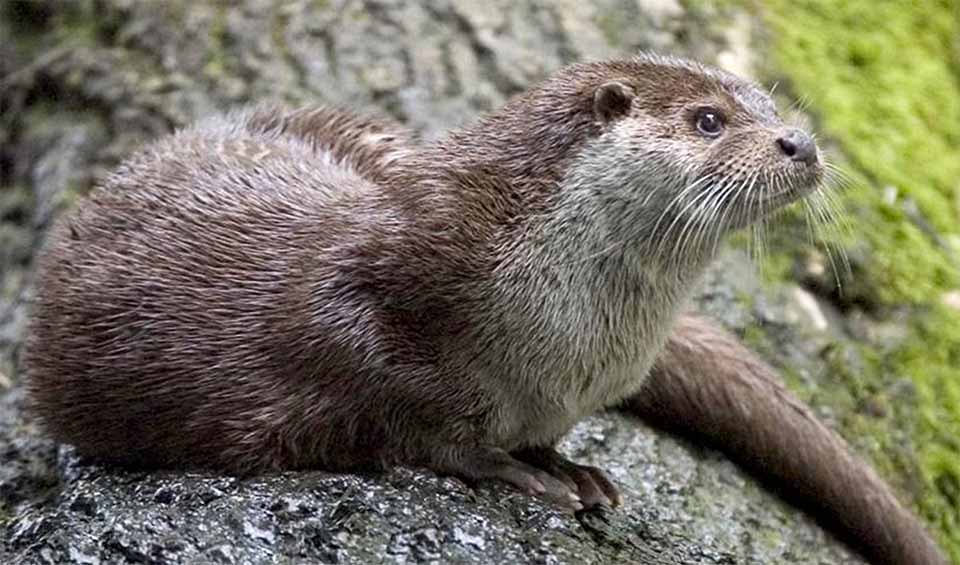Possessing sleek, waterproof fur, webbed feet, and keen senses, these charismatic creatures navigate their watery domains with grace and agility. Their long, streamlined bodies are covered in dense, waterproof fur, providing insulation and protection against the elements while swimming. Notably, their fur exhibits a dark brown hue on their back, gradually fading to a lighter shade on their belly, aiding in camouflage and thermoregulation.
Eurasian otters boast a diverse range of adaptations that enable them to thrive in aquatic habitats. Their webbed feet facilitate efficient propulsion through the water, allowing them to navigate swiftly and gracefully in search of prey. Furthermore, their acute senses, including keen eyesight and acute sense of smell, aid in locating food sources beneath the water’s surface, while sensitive whiskers help detect subtle changes in their aquatic environment.
As opportunistic predators, Eurasian otters exhibit a varied diet composed primarily of fish, supplemented by amphibians, crustaceans, mollusks, and occasionally small mammals and birds. Their piscivorous diet reflects their reliance on freshwater and coastal habitats rich in aquatic prey species. Additionally, Eurasian otters play a crucial role in regulating prey populations, helping to maintain ecosystem balance and biodiversity in their aquatic ecosystems.
Historically, Eurasian otters faced significant threats to their survival, including habitat loss, pollution, and overexploitation of their fur. Human activities such as habitat destruction, pollution, and hunting led to population declines across much of their range. However, concerted conservation efforts have helped to mitigate these threats and stabilize Eurasian otter populations in many areas.
Distribution
 Afghanistan
Afghanistan Albania
Albania Algeria
Algeria Andorra
Andorra Armenia
Armenia Austria
Austria Azerbaijan
Azerbaijan Bangladesh
Bangladesh Belarus
Belarus Belgium
Belgium Bhutan
Bhutan Bosnia And Herz.
Bosnia And Herz. Bulgaria
Bulgaria Cambodia
Cambodia China
China Croatia
Croatia Czechia
Czechia Denmark
Denmark Estonia
Estonia Finland
Finland France
France Georgia
Georgia Germany
Germany Gibraltar
Gibraltar Greece
Greece Hong Kong
Hong Kong Hungary
Hungary India
India Indonesia
Indonesia Iran
Iran Iraq
Iraq Ireland
Ireland Israel
Israel Official estimate
Official estimate
 Italy
Italy Official estimate
Official estimate
 Japan
Japan Jordan
Jordan Kazakhstan
Kazakhstan Official estimate
Official estimate
 Korea
Korea Kyrgyzstan
Kyrgyzstan Laos
Laos Latvia
Latvia Lebanon
Lebanon Liechtenstein
Liechtenstein Lithuania
Lithuania Luxembourg
Luxembourg Malaysia
Malaysia Moldova
Moldova Mongolia
Mongolia Montenegro
Montenegro Morocco
Morocco Myanmar
Myanmar Nepal
Nepal Netherlands
Netherlands North Korea
North Korea North Macedonia
North Macedonia Norway
Norway Pakistan
Pakistan Poland
Poland Portugal
Portugal Romania
Romania Russia
Russia Official estimate
Official estimate
 San Marino
San Marino Serbia
Serbia Slovakia
Slovakia Slovenia
Slovenia Spain
Spain Sri Lanka
Sri Lanka Sweden
Sweden Switzerland
Switzerland Syria
Syria Taiwan
Taiwan Tajikistan
Tajikistan Thailand
Thailand Tunisia
Tunisia Turkey
Turkey Turkmenistan
Turkmenistan Ukraine
Ukraine United Kingdom
United Kingdom Official estimate
Official estimate
 Uzbekistan
Uzbekistan Vietnam
VietnamAnything we've missed?
Help us improve this page by suggesting edits. Glory never dies!
Suggest an editGet to know me
Terrestrial / Aquatic
Altricial / Precocial
Polygamous / Monogamous
Dimorphic / Monomorphic
Active: Diurnal / Nocturnal
Social behavior: Solitary / Pack / Herd
Diet: Carnivore / Herbivore / Omnivore / Piscivorous / Insectivore
Migratory: Yes / No
Domesticated: Yes / No
Dangerous: Yes / No






